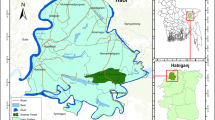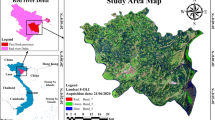Abstract
Classifying multi-temporal image data to produce thematic maps and quantify land cover changes is one of the most common applications of remote sensing. Mapping land cover changes at the regional level is essential for a wide range of applications including land use planning, decision making, land cover database generation, and as a source of information for sustainable management of natural resources. Land cover changes in Lake Hawassa Watershed, Southern Ethiopia, were investigated using Landsat MSS image data of 1973, and Landsat TM images of 1985, 1995, and 2011, covering a period of nearly four decades. Each image was partitioned in a GIS environment, and classified using an unsupervised algorithm followed by a supervised classification method. A hybrid approach was employed in order to reduce spectral confusion due to high variability of land cover. Classification of satellite image data was performed integrating field data, aerial photographs, topographical maps, medium resolution satellite image (SPOT 20 m), and visual image interpretation. The image data were classified into nine land cover types: water, built-up, cropland, woody vegetation, forest, grassland, swamp, bare land, and scrub. The overall accuracy of the LULC maps ranged from 82.5 to 85.0 %. The achieved accuracies were reasonable, and the observed classification errors were attributable to coarse spatial resolution and pixels containing a mixture of cover types. Land cover change statistics were extracted and tabulated using the ERDAS Imagine software. The results indicated an increase in built-up area, cropland, and bare land areas, and a reduction in the six other land cover classes. Predominant land cover is cropland changing from 43.6 % in 1973 to 56.4 % in 2011. A significant portion of land cover was converted into cropland. Woody vegetation and forest cover which occupied 21.0 and 10.3 % in 1973, respectively, diminished to 13.6 and 5.6 % in 2011. The change in water body was very peculiar in that the area of Lake Hawassa increased from 91.9 km2 in 1973 to 95.2 km2 in 2011, while that of Lake Cheleleka whose area was 11.3 km2 in 1973 totally vanished in 2011 and transformed into mud-flat and grass dominated swamp. The “change and no change” analysis revealed that more than one third (548.0 km2) of the total area was exposed to change between 1973 and 2011. This study was useful in identifying the major land cover changes, and the analysis pursued provided a valuable insight into the ongoing changes in the area under investigation.






Similar content being viewed by others
References
Abd El-Kawy, O. R., Rød, J. K., Ismail, H. A., & Suliman, A. S. (2010). Land use and land cover change detection in the western Nile delta of Egypt using remote sensing data. Applied Geography, 31, 483–494.
Abinet, A., Getachew, A., & Tadesse, A. (2011). Hawassa City Administration, 2002EC/2009GC socio economic profile. Hawassa: Finance & Economic Development Data Collection and Dissemination Work Process.
Anderson, J. R., Hardy, E. E., Roach, J. T., & Witmer, R. E. (1976). A land use and land cover classification system for use with remote sensor data. USGS Professional Paper 964, USA.
Aplin, P. (2004). Remote sensing: land cover. Progress in Physical Geography, 28(2), 283–293.
Bedru, S. M. (2010). Remote sensing & GIS for land Cover/land use change detection and analysis in the semi-natural ecosystems and agriculture landscapes of the central Ethiopian Rift Valley. Thesis / Dissertation. Rhombos-Verlag, Berlin, Germany
Brink, A. B., & Eva, H. D. (2009). Monitoring 25 years of land cover change dynamics in Africa: a sample based remote sensing approach. Applied Geography, 29, 501–512.
Congalton, R. G. (1991). A review of assessing the accuracy of classifications of remotely sensed data. Remote Sens Environment, 37, 35–46.
Congalton, R. G. (2001). Accuracy assessment and validation of remotely sensed and other spatial information. International Journal of Wildland Fire, 10, 321–328.
Congalton, R. G., & Green, K. (2009). Assessing the accuracy of remotely sensed data: principles and practices (2nd ed.). Boca Raton: Taylor & Francis.
Coppin, P., Jonckheere, K., Nackaerts, K., & Muys, B. (2004). Digital change detection methods in ecosystem monitoring: a review. International Journal of Remote Sensing, 25(9), 1565–1596.
Das, T. (2009). Land use and land cover change detection: an object oriented approach. MSc Thesis. Munster, Germany
Demelash, A. (2008). Assessment of non-point source pollution in Lake Awassa Watershed using the annualized agricultural non-point source (AnnAGNPS) model. MSc Thesis. Addis Ababa University, Ethiopia.
Dessie, G., & Christiansson, C. (2008). Forest decline and its causes in the south-central rift valley of Ethiopia: human impact over a one hundred year perspective. Ambio, 37(4), 263–271.
Dewan, A. M., & Yamaguchi, Y. (2009). Land use and land cover change in greater Dhaka, Bangladesh: using remote sensing to promote sustainable urbanization. Applied Geography, 29, 390–401.
ERDAS. (2005). ERDAS Field Guide: Leica Geosystems Geospatial Imaging LLC, Norcross, GA
FAO. (1997). Food and Agriculture Organization of the United Nations. Estimating Biomass and Biomass Change in Tropical Forests. http://www.fao.org/docrep/W4095E/W4095E00.htm. Accessed June, 2010.
FCSG. (2010). Forest Cover Shrinking Globally. Proceedings of the National Academy of Sciences (PNAS), issue 26–30. http://www.redorbit.com/news/science/1855654/forest_cover_shrinking_globally/?print=true. Accessed August, 2011.
Foody, G. M. (2002). Status of land cover classification accuracy assessment. Remote Sensing of Environment, 80, 185–201.
Hussien, A., Descheemaeker, K., Steenhuis, T. S., & Pandey, S. (2011). Comparison of land use and land cover changes, drivers and impacts for a moisture-sufficient and drought-prone region in the Ethiopian Highlands. Experimental Agriculture, 47(S1), 71–83 C.
Jensen, J. R. (2005). Introductory digital image processing: a remote sensing perspective (3rd ed.). Upper Saddle River: Pearson Prentice Hall.
Lambin, E. F., Geist, H. J., & Lepers, E. (2003). Dynamics of land-use and land-cover change in tropical regions. Annual Review of Environment and Resources, 28, 205–241.
Lillesand, T. M., & Kiefer, R. W. (2000). Remote sensing and image interpretation (4th ed.). USA: Wiley.
Liu, J., & Taylor, W. W. (2002). Integrating landscape ecology into natural resources management. UK: Cambridge University Press.
Liu, W., Gopal, S., & Woodcock, C. E. (2004). Uncertainty and confidence in land cover classification using a hybrid classification approach. Photogrammetric Engineering & Remote Sensing, 70(8), 963–971.
Lo, C. P., & Yeung, A. W. (2002). Concepts and techniques of geographic information systems. Upper Saddle River: Prentice-Hall.
Lu, D., & Weng, Q. (2007). A survey of image classification methods and techniques for improving classification performance. International Journal of Remote Sensing, 28(5), 823–870.
Mather, P. M. (1987). Computer processing of remotely-sensed images: an introduction. St. Edmunds: St. Edmundsbury Press.
Million, B. (2001). Forestry Outlook Studies in Africa, Ethiopia.
Okeke, F., & Karnieli, A. (2006). Methods for fuzzy classification and accuracy assessment of historical aerial photographs for vegetation change analyses. Part I: algorithm development. International Journal of Remote Sensing, 27(1–2), 153–176.
Rembold, F., Carnicelli, S., Nori, M., & Ferrari, G. A. (2000). Use of aerial photographs, Landsat TM imagery and multidisciplinary field survey for land-cover change analysis in the lakes region, Ethiopia. JAG, 2(3/4).
Rogan, J., & Chen, D. (2004). Remote sensing technology for mapping and monitoring land-cover and land-use change. Progress in Planning, 61, 301–325.
Rozenstein, O., & Karnieli, A. (2011). Comparison of methods for land-use classification incorporating remote sensing and GIS inputs. Applied Geography, 31, 533–544.
Samimi, C., & Kraus, T. (2004). Biomass estimation using Landsat-TM and -ETM+. Towards a regional model for Southern Africa? GeoJournal, 59, 177–187.
Seto, K. C., Woodcock, C. E., Song, C., Huang, X., Lu, J., & Kaufmann, R. K. (2002). Monitoring land-use change in the Pearl River Delta using Landsat TM. International Journal of Remote Sensing, 23(10), 1985–2004.
Tenalem, A., & Yemane, G. (2006). Application of a spreadsheet hydrological model for computing the long-term water balance of Lake Awassa, Ethiopia. Hydrological Sciences Journal, 51(3), 418–431.
Vitousek, P. M., Mooney, H. A., Lubchenco, J., & Melillo, J. M. (1997). Human domination of earth’s ecosystems. Science, 277(5325), 494–499.
WCED. (1987). World Commission on Environment and Development. Our common future. Oxford: Oxford University Press.
Wilkinson, L. (1998). SYSTAT 8.0 Statistics, USA
Wilson, E. O., & Peter, F. M. (1988). Biodiversity. National Academy Press, Washington, D. C. http://www.nap.edu/catalog/989.html. Accessed January 8, 2013.
Yemane, G. (2004). Assessment of the water balance of Lake Awassa Catchment, Ethiopia. MSc Thesis. International Institute for Geo-Information and Earth Observation, Enschde, The Netherlands
Zubair, A. O. (2006). Change detection in land use and Land cover using remote sensing data and GIS: A case study of Ilorin and its environs in Kwara State. MSc Thesis. University of Ibadan, Nigeria
Acknowledgments
This work is funded by Norwegian Agency for Development Cooperation as part of capacity building at Hawassa University, Ethiopia. We gratefully acknowledge the financial support. Authors are also thankful to the two anonymous reviewers for their valuable comments.
Author information
Authors and Affiliations
Corresponding author
Rights and permissions
About this article
Cite this article
Nigatu Wondrade, Dick, Ø.B. & Tveite, H. GIS based mapping of land cover changes utilizing multi-temporal remotely sensed image data in Lake Hawassa Watershed, Ethiopia. Environ Monit Assess 186, 1765–1780 (2014). https://doi.org/10.1007/s10661-013-3491-x
Received:
Accepted:
Published:
Issue Date:
DOI: https://doi.org/10.1007/s10661-013-3491-x




